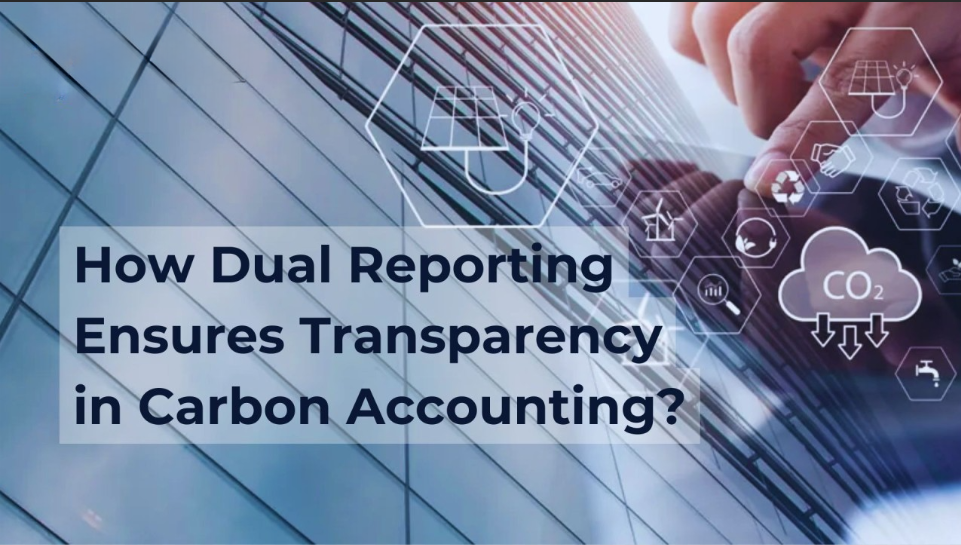
As businesses strive to align with sustainability goals, accurate carbon accounting has become a fundamental requirement. A critical aspect of this process is Scope 2 emissions, which refer to indirect greenhouse gas (GHG) emissions from purchased electricity, steam, heating, or cooling.
Companies are required to report Scope 2 emissions using two distinct methods:
- Location-Based Reporting: This method calculates emissions based on the average emissions intensity of the regional electricity grid where energy consumption occurs.
- Market-Based Reporting: This approach accounts for emissions based on the specific energy sources a company has procured, including renewable energy contracts.
The practice of dual reporting involves disclosing emissions using both methods to provide a complete and transparent view of a company’s environmental impact. This ensures stakeholders can differentiate between emission reductions that result from improvements in the electricity grid and those stemming from a company’s deliberate energy procurement choices.
Technical Breakdown: How to Implement Dual Reporting
Dual reporting requires companies to measure their emissions using two methods: location-based, which reflects the regional electricity grid mix, and market-based, which accounts for the company’s energy procurement choices. Understanding how to implement both methods ensures accurate and transparent carbon accounting.
– Location-Based Reporting (Grid-Based Approach)
Definition: The location-based method calculates emissions based on the average emissions intensity of the electricity grid where the company operates. It represents the general carbon footprint of the grid without considering an organization’s specific electricity purchases.
Key Data Requirements:
- Grid emission factors, which indicate how much CO₂ is emitted per unit of electricity, published by national or international agencies such as the Central Electricity Authority (CEA) of India or the International Energy Agency (IEA).
- Total electricity consumption of each facility, measured in megawatt-hours (MWh).
Example: A manufacturing plant in Maharashtra, India, consumes 100 MWh of electricity. Its location-based emissions are calculated using the average emissions factor of Maharashtra’s electricity grid, which includes coal, hydro, solar, and wind power sources. Since Maharashtra’s power mix relies significantly on coal, its location-based emissions may be high even if cleaner energy sources are available elsewhere in the country.
– Market-Based Reporting (Contract-Based Approach)
Definition: The market-based method calculates emissions based on the specific energy sources a company has actively chosen through purchasing decisions. It reflects emissions from contracted electricity sources, rather than the general grid mix.
Key Data Requirements:
- Direct electricity purchases from suppliers, including contracts for renewable energy.
- Renewable energy certificates (RECs) or Green Energy Open Access (GEOA) purchases, which certify that a company has sourced a portion of its electricity from renewables.
Example: If a company in Maharashtra purchases solar power through Green Open Access for 50% of its electricity use, its market-based emissions will be lower than its location-based emissions. This reflects the company’s efforts to reduce its carbon footprint by choosing renewable energy rather than relying solely on the regional power grid.
Key Differences Between the Two Methods
The table below highlights the key differences between the location-based and market-based methods, showing how emissions are calculated based on grid intensity versus specific energy purchases.

Purpose of Dual Reporting
Dual reporting ensures a comprehensive and transparent approach to emissions accounting by capturing both grid-based emissions and the impact of a company’s energy procurement choices. It serves three key purposes: transparency, informed decision-making, and effective stakeholder communication.
- Enhancing Performance Assessment
Dual reporting helps organizations evaluate the impact of their energy sourcing strategies and regional electricity grid changes separately. For instance, if a company procures renewable energy through direct contracts, its market-based emissions will decrease, even if the regional grid still relies on fossil fuels, keeping location-based emissions high.
- Strengthening Stakeholder Communication
Investors, regulators, and consumers increasingly demand greater transparency in corporate sustainability efforts. Dual reporting provides a clearer picture of whether emission reductions are due to actual changes in a company’s procurement strategy or external factors such as grid decarbonization.
- Regulatory Compliance
Many international sustainability frameworks require dual reporting to ensure comparability and consistency in emissions disclosure. Businesses that implement this approach are better equipped to comply with evolving environmental regulations across multiple jurisdictions.
Challenges in Dual Reporting
While dual reporting enhances transparency and compliance, it also presents challenges such as data complexity, higher administrative costs, and risks of misleading sustainability claims.
- Complexity in Data Collection
Dual reporting requires companies to track energy consumption, procurement contracts, and emissions factors across different locations. Since emission factors vary by country and region, obtaining accurate and consistent data can be difficult. Companies operating in multiple regions often struggle with inconsistent reporting requirements and data availability.
- Increased Administrative Costs
Because dual reporting involves two separate calculations (location-based and market-based emissions), it increases the workload and costs for businesses. Small and medium enterprises (SMEs), which may have limited resources, face additional financial and operational burdens when complying with multiple reporting standards.
- Potential for Greenwashing
Greenwashing occurs when companies misrepresent their environmental impact to appear more sustainable than they actually are. Some businesses lower their reported market-based emissions by purchasing renewable energy certificates (RECs) without genuinely reducing their energy use or improving efficiency. To prevent misleading claims, regulators are introducing stricter guidelines and verification processes to ensure transparency and accountability in emissions reporting.
Key Frameworks and Regulatory Requirements
Several global sustainability frameworks mandate or recommend dual reporting. The following are some of the key regulations:

Companies operating in multiple regions must align their reporting with these frameworks to meet regulatory expectations and enhance investor confidence.
Future Trends in Dual Reporting
As sustainability regulations evolve, businesses are adopting streamlined reporting through global standards alignment, advanced technology, and integrated financial-sustainability disclosures.
- Global Harmonization of Reporting Standards:
International standards like IFRS (International Financial Reporting Standards), EU CSRD (Corporate Sustainability Reporting Directive), and U.S. SEC Climate Disclosure Rules are moving toward greater alignment. This will help simplify reporting requirements, reduce inconsistencies, and make it easier for companies to comply with multiple regulations.
- Technological Advancements in Carbon Accounting:
New technologies such as AI-powered reporting tools and blockchain-based emissions tracking are making sustainability reporting more accurate, transparent, and efficient. These tools help companies automate data collection, verify emissions data, and improve compliance with reporting standards.
- Integrated Financial and Sustainability Reporting:
Companies are increasingly combining financial data with sustainability reports to provide a more comprehensive view of their overall performance. This approach helps investors and stakeholders understand both financial risks and environmental impacts, leading to better decision-making and long-term planning.
Conclusion
Dual reporting is essential for ensuring accuracy, transparency, and compliance in emissions accounting. By disclosing both location-based and market-based emissions, businesses can:
- Provide a clear and credible picture of their sustainability efforts.
- Improve stakeholder confidence by demonstrating accountability.
- Prepare for increasingly stringent global climate regulations.
As sustainability reporting evolves, organizations must invest in robust data management systems and align with international best practices to stay ahead in an increasingly regulated environment.










